Analysis of Soil Properties under Wastewater Irrigation: A Study
VerifiedAdded on 2023/06/04
|9
|2574
|95
Report
AI Summary
This engineering project report investigates the effects of wastewater irrigation on soil properties, focusing on how different wastewater sources impact soil characteristics. The study examines the filtration capabilities of soil, its ability to provide nutrients to plants, and the effects of both primary and secondary wastewater sources on soil. The research also assesses the physicochemical properties of soil, particularly in areas affected by industrial pollution, with a focus on soil pH and the calculation of a soil index. The report highlights how wastewater can affect soil quality, potentially leading to a deterioration of soil properties and the accumulation of heavy metals. The findings provide valuable information for commercial farmers and offer recommendations for managing plants and soil resources effectively, emphasizing the importance of understanding the environmental impact of wastewater irrigation. The study also reviews the literature on soil properties, pollution, and the effects of wastewater on soil composition.
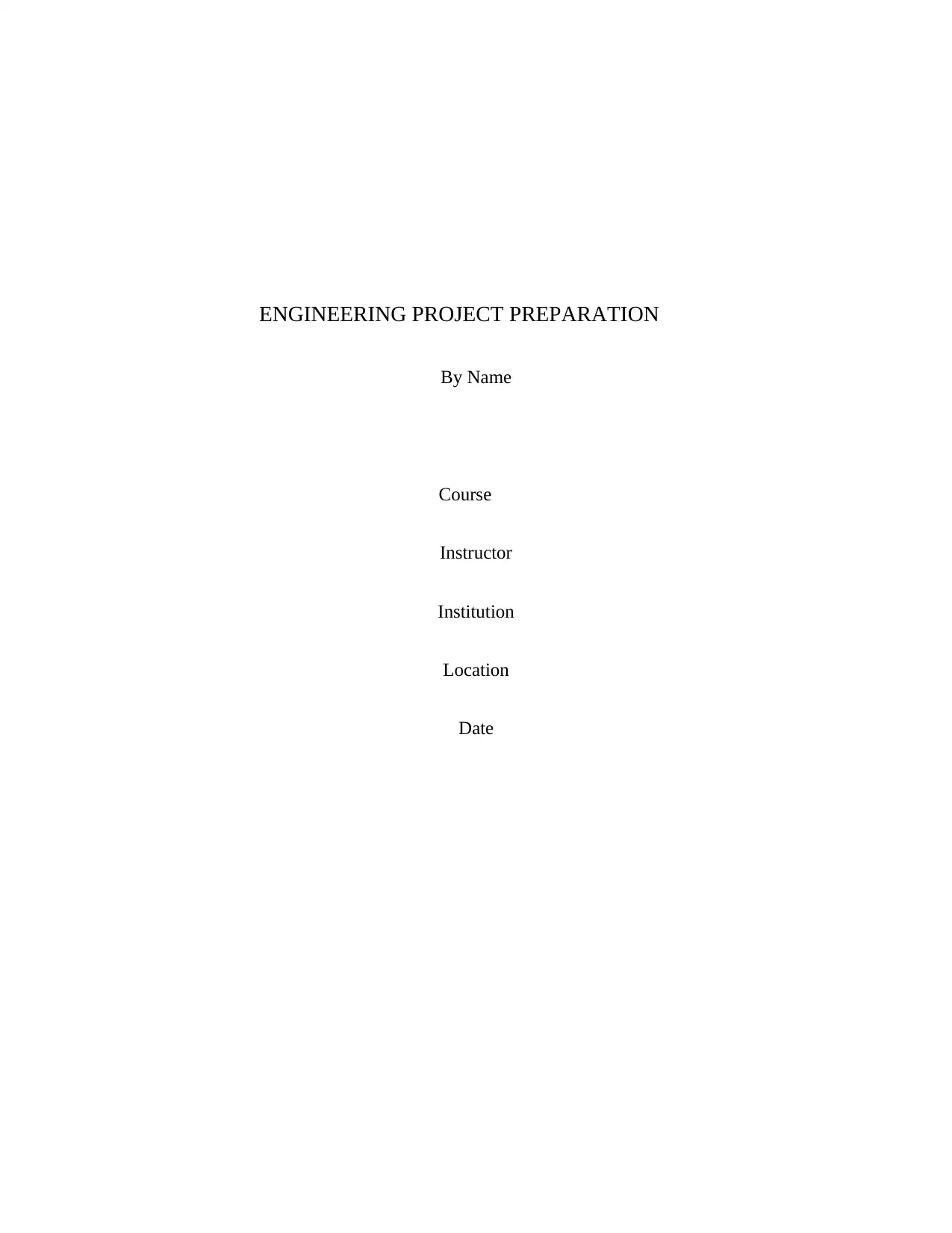
ENGINEERING PROJECT PREPARATION
By Name
Course
Instructor
Institution
Location
Date
By Name
Course
Instructor
Institution
Location
Date
Paraphrase This Document
Need a fresh take? Get an instant paraphrase of this document with our AI Paraphraser
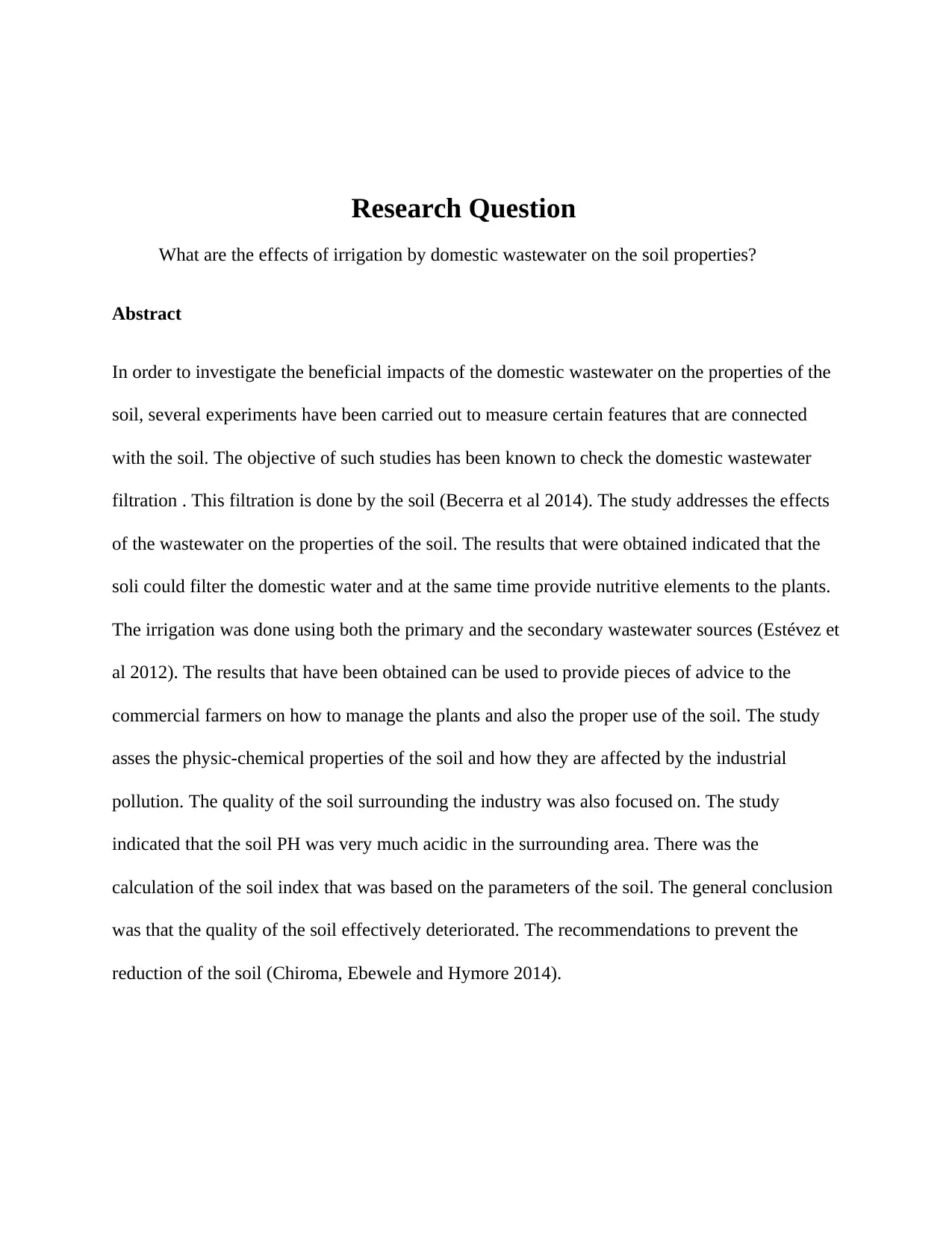
Research Question
What are the effects of irrigation by domestic wastewater on the soil properties?
Abstract
In order to investigate the beneficial impacts of the domestic wastewater on the properties of the
soil, several experiments have been carried out to measure certain features that are connected
with the soil. The objective of such studies has been known to check the domestic wastewater
filtration . This filtration is done by the soil (Becerra et al 2014). The study addresses the effects
of the wastewater on the properties of the soil. The results that were obtained indicated that the
soli could filter the domestic water and at the same time provide nutritive elements to the plants.
The irrigation was done using both the primary and the secondary wastewater sources (Estévez et
al 2012). The results that have been obtained can be used to provide pieces of advice to the
commercial farmers on how to manage the plants and also the proper use of the soil. The study
asses the physic-chemical properties of the soil and how they are affected by the industrial
pollution. The quality of the soil surrounding the industry was also focused on. The study
indicated that the soil PH was very much acidic in the surrounding area. There was the
calculation of the soil index that was based on the parameters of the soil. The general conclusion
was that the quality of the soil effectively deteriorated. The recommendations to prevent the
reduction of the soil (Chiroma, Ebewele and Hymore 2014).
What are the effects of irrigation by domestic wastewater on the soil properties?
Abstract
In order to investigate the beneficial impacts of the domestic wastewater on the properties of the
soil, several experiments have been carried out to measure certain features that are connected
with the soil. The objective of such studies has been known to check the domestic wastewater
filtration . This filtration is done by the soil (Becerra et al 2014). The study addresses the effects
of the wastewater on the properties of the soil. The results that were obtained indicated that the
soli could filter the domestic water and at the same time provide nutritive elements to the plants.
The irrigation was done using both the primary and the secondary wastewater sources (Estévez et
al 2012). The results that have been obtained can be used to provide pieces of advice to the
commercial farmers on how to manage the plants and also the proper use of the soil. The study
asses the physic-chemical properties of the soil and how they are affected by the industrial
pollution. The quality of the soil surrounding the industry was also focused on. The study
indicated that the soil PH was very much acidic in the surrounding area. There was the
calculation of the soil index that was based on the parameters of the soil. The general conclusion
was that the quality of the soil effectively deteriorated. The recommendations to prevent the
reduction of the soil (Chiroma, Ebewele and Hymore 2014).
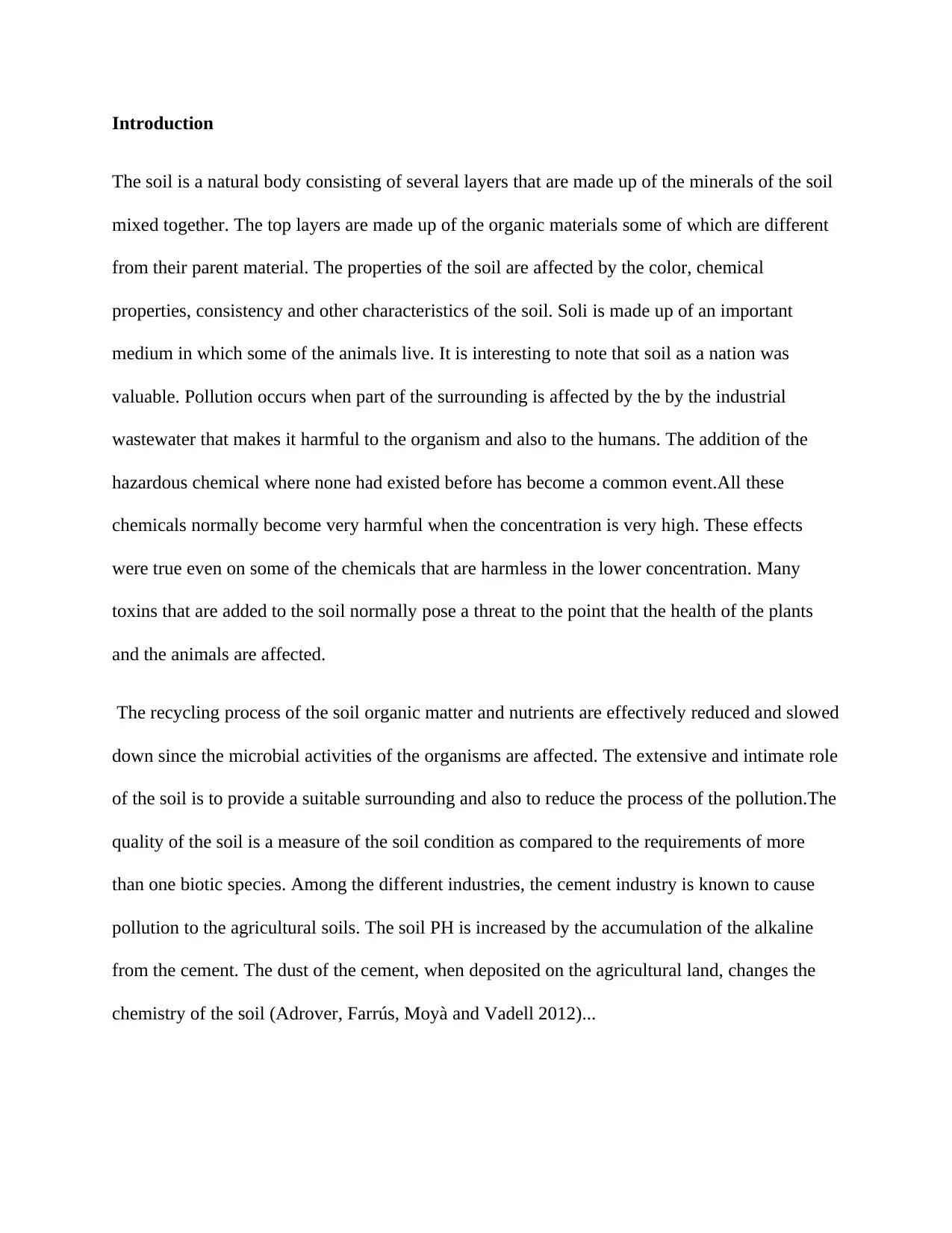
Introduction
The soil is a natural body consisting of several layers that are made up of the minerals of the soil
mixed together. The top layers are made up of the organic materials some of which are different
from their parent material. The properties of the soil are affected by the color, chemical
properties, consistency and other characteristics of the soil. Soli is made up of an important
medium in which some of the animals live. It is interesting to note that soil as a nation was
valuable. Pollution occurs when part of the surrounding is affected by the by the industrial
wastewater that makes it harmful to the organism and also to the humans. The addition of the
hazardous chemical where none had existed before has become a common event.All these
chemicals normally become very harmful when the concentration is very high. These effects
were true even on some of the chemicals that are harmless in the lower concentration. Many
toxins that are added to the soil normally pose a threat to the point that the health of the plants
and the animals are affected.
The recycling process of the soil organic matter and nutrients are effectively reduced and slowed
down since the microbial activities of the organisms are affected. The extensive and intimate role
of the soil is to provide a suitable surrounding and also to reduce the process of the pollution.The
quality of the soil is a measure of the soil condition as compared to the requirements of more
than one biotic species. Among the different industries, the cement industry is known to cause
pollution to the agricultural soils. The soil PH is increased by the accumulation of the alkaline
from the cement. The dust of the cement, when deposited on the agricultural land, changes the
chemistry of the soil (Adrover, Farrús, Moyà and Vadell 2012)...
The soil is a natural body consisting of several layers that are made up of the minerals of the soil
mixed together. The top layers are made up of the organic materials some of which are different
from their parent material. The properties of the soil are affected by the color, chemical
properties, consistency and other characteristics of the soil. Soli is made up of an important
medium in which some of the animals live. It is interesting to note that soil as a nation was
valuable. Pollution occurs when part of the surrounding is affected by the by the industrial
wastewater that makes it harmful to the organism and also to the humans. The addition of the
hazardous chemical where none had existed before has become a common event.All these
chemicals normally become very harmful when the concentration is very high. These effects
were true even on some of the chemicals that are harmless in the lower concentration. Many
toxins that are added to the soil normally pose a threat to the point that the health of the plants
and the animals are affected.
The recycling process of the soil organic matter and nutrients are effectively reduced and slowed
down since the microbial activities of the organisms are affected. The extensive and intimate role
of the soil is to provide a suitable surrounding and also to reduce the process of the pollution.The
quality of the soil is a measure of the soil condition as compared to the requirements of more
than one biotic species. Among the different industries, the cement industry is known to cause
pollution to the agricultural soils. The soil PH is increased by the accumulation of the alkaline
from the cement. The dust of the cement, when deposited on the agricultural land, changes the
chemistry of the soil (Adrover, Farrús, Moyà and Vadell 2012)...
⊘ This is a preview!⊘
Do you want full access?
Subscribe today to unlock all pages.

Trusted by 1+ million students worldwide
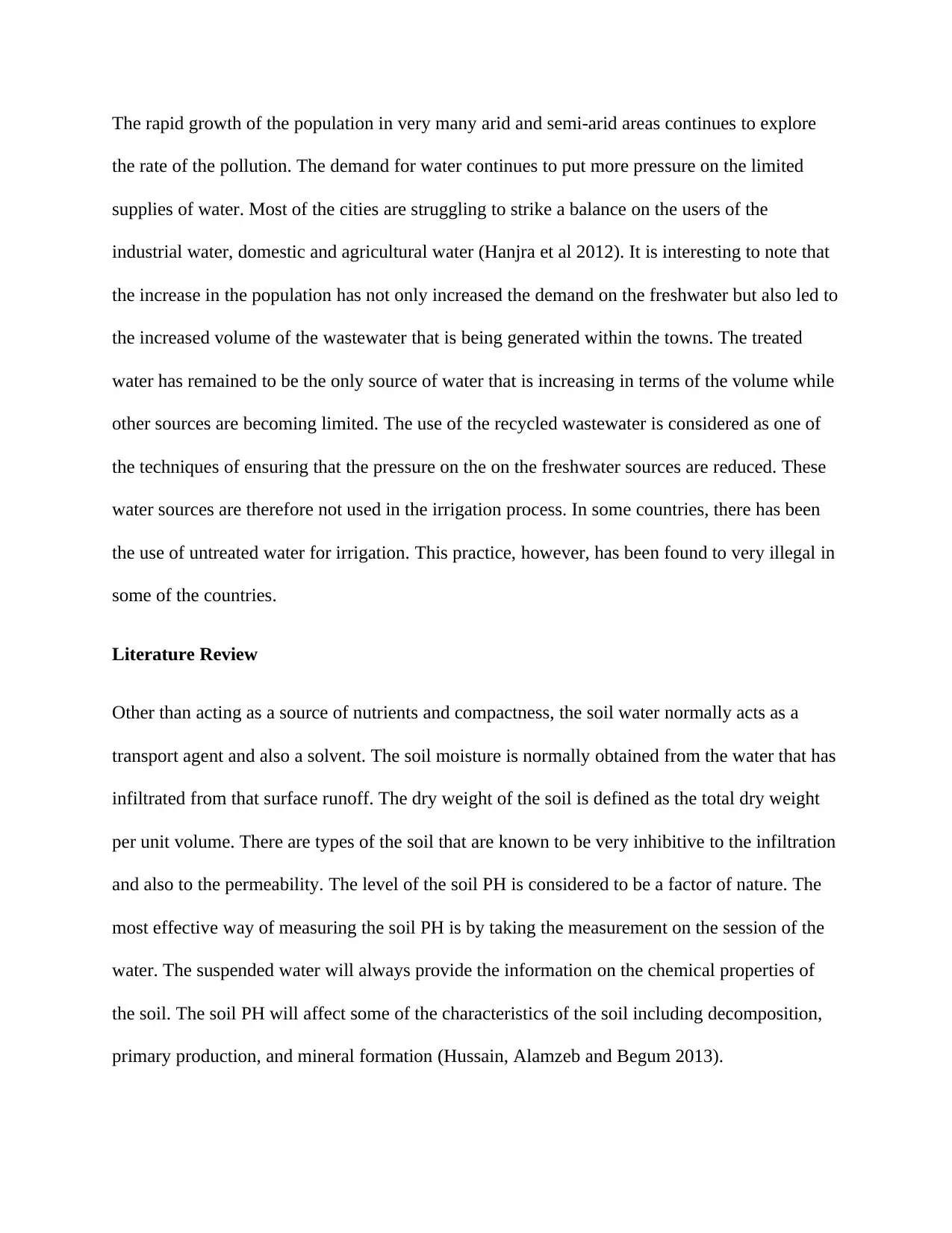
The rapid growth of the population in very many arid and semi-arid areas continues to explore
the rate of the pollution. The demand for water continues to put more pressure on the limited
supplies of water. Most of the cities are struggling to strike a balance on the users of the
industrial water, domestic and agricultural water (Hanjra et al 2012). It is interesting to note that
the increase in the population has not only increased the demand on the freshwater but also led to
the increased volume of the wastewater that is being generated within the towns. The treated
water has remained to be the only source of water that is increasing in terms of the volume while
other sources are becoming limited. The use of the recycled wastewater is considered as one of
the techniques of ensuring that the pressure on the on the freshwater sources are reduced. These
water sources are therefore not used in the irrigation process. In some countries, there has been
the use of untreated water for irrigation. This practice, however, has been found to very illegal in
some of the countries.
Literature Review
Other than acting as a source of nutrients and compactness, the soil water normally acts as a
transport agent and also a solvent. The soil moisture is normally obtained from the water that has
infiltrated from that surface runoff. The dry weight of the soil is defined as the total dry weight
per unit volume. There are types of the soil that are known to be very inhibitive to the infiltration
and also to the permeability. The level of the soil PH is considered to be a factor of nature. The
most effective way of measuring the soil PH is by taking the measurement on the session of the
water. The suspended water will always provide the information on the chemical properties of
the soil. The soil PH will affect some of the characteristics of the soil including decomposition,
primary production, and mineral formation (Hussain, Alamzeb and Begum 2013).
the rate of the pollution. The demand for water continues to put more pressure on the limited
supplies of water. Most of the cities are struggling to strike a balance on the users of the
industrial water, domestic and agricultural water (Hanjra et al 2012). It is interesting to note that
the increase in the population has not only increased the demand on the freshwater but also led to
the increased volume of the wastewater that is being generated within the towns. The treated
water has remained to be the only source of water that is increasing in terms of the volume while
other sources are becoming limited. The use of the recycled wastewater is considered as one of
the techniques of ensuring that the pressure on the on the freshwater sources are reduced. These
water sources are therefore not used in the irrigation process. In some countries, there has been
the use of untreated water for irrigation. This practice, however, has been found to very illegal in
some of the countries.
Literature Review
Other than acting as a source of nutrients and compactness, the soil water normally acts as a
transport agent and also a solvent. The soil moisture is normally obtained from the water that has
infiltrated from that surface runoff. The dry weight of the soil is defined as the total dry weight
per unit volume. There are types of the soil that are known to be very inhibitive to the infiltration
and also to the permeability. The level of the soil PH is considered to be a factor of nature. The
most effective way of measuring the soil PH is by taking the measurement on the session of the
water. The suspended water will always provide the information on the chemical properties of
the soil. The soil PH will affect some of the characteristics of the soil including decomposition,
primary production, and mineral formation (Hussain, Alamzeb and Begum 2013).
Paraphrase This Document
Need a fresh take? Get an instant paraphrase of this document with our AI Paraphraser
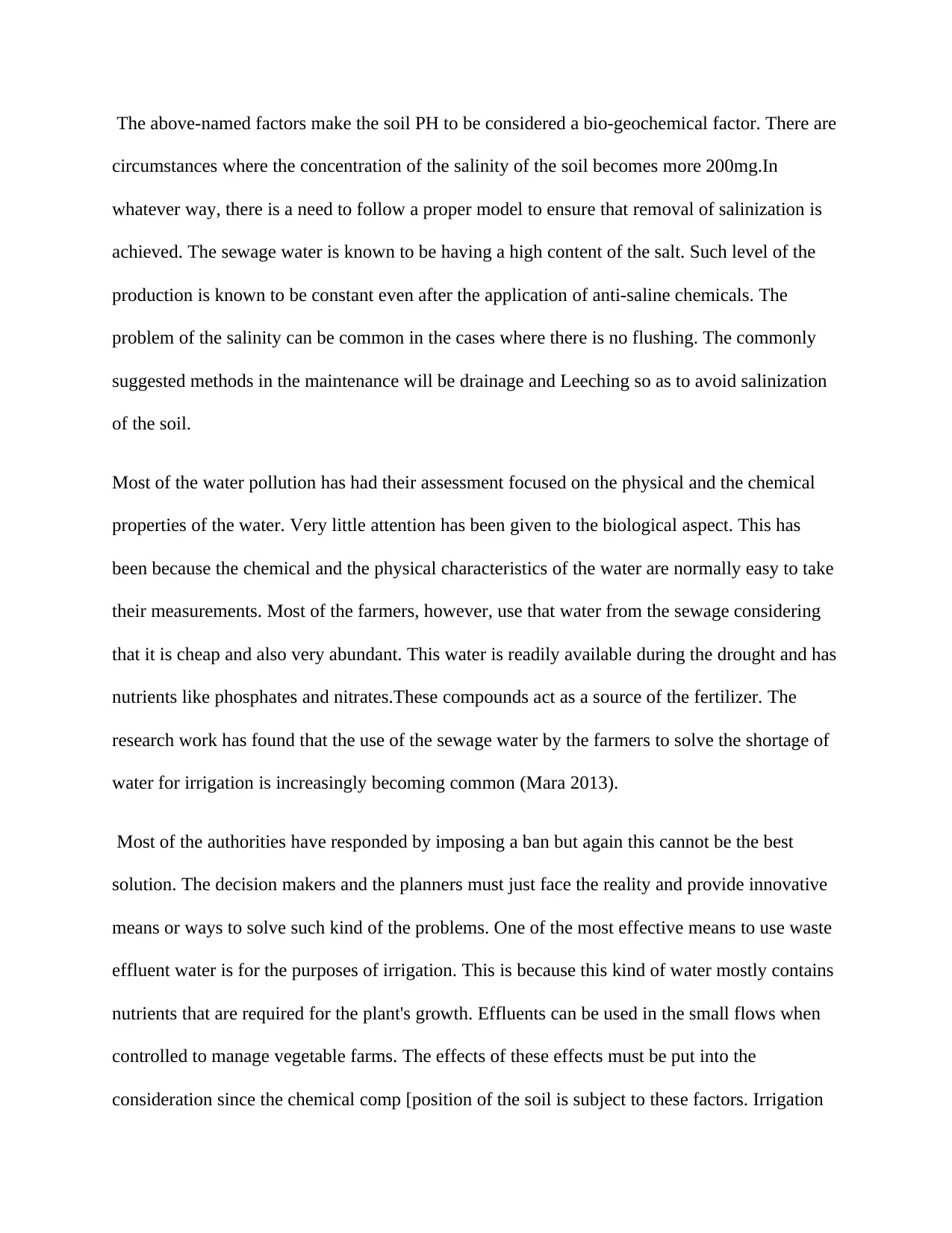
The above-named factors make the soil PH to be considered a bio-geochemical factor. There are
circumstances where the concentration of the salinity of the soil becomes more 200mg.In
whatever way, there is a need to follow a proper model to ensure that removal of salinization is
achieved. The sewage water is known to be having a high content of the salt. Such level of the
production is known to be constant even after the application of anti-saline chemicals. The
problem of the salinity can be common in the cases where there is no flushing. The commonly
suggested methods in the maintenance will be drainage and Leeching so as to avoid salinization
of the soil.
Most of the water pollution has had their assessment focused on the physical and the chemical
properties of the water. Very little attention has been given to the biological aspect. This has
been because the chemical and the physical characteristics of the water are normally easy to take
their measurements. Most of the farmers, however, use that water from the sewage considering
that it is cheap and also very abundant. This water is readily available during the drought and has
nutrients like phosphates and nitrates.These compounds act as a source of the fertilizer. The
research work has found that the use of the sewage water by the farmers to solve the shortage of
water for irrigation is increasingly becoming common (Mara 2013).
Most of the authorities have responded by imposing a ban but again this cannot be the best
solution. The decision makers and the planners must just face the reality and provide innovative
means or ways to solve such kind of the problems. One of the most effective means to use waste
effluent water is for the purposes of irrigation. This is because this kind of water mostly contains
nutrients that are required for the plant's growth. Effluents can be used in the small flows when
controlled to manage vegetable farms. The effects of these effects must be put into the
consideration since the chemical comp [position of the soil is subject to these factors. Irrigation
circumstances where the concentration of the salinity of the soil becomes more 200mg.In
whatever way, there is a need to follow a proper model to ensure that removal of salinization is
achieved. The sewage water is known to be having a high content of the salt. Such level of the
production is known to be constant even after the application of anti-saline chemicals. The
problem of the salinity can be common in the cases where there is no flushing. The commonly
suggested methods in the maintenance will be drainage and Leeching so as to avoid salinization
of the soil.
Most of the water pollution has had their assessment focused on the physical and the chemical
properties of the water. Very little attention has been given to the biological aspect. This has
been because the chemical and the physical characteristics of the water are normally easy to take
their measurements. Most of the farmers, however, use that water from the sewage considering
that it is cheap and also very abundant. This water is readily available during the drought and has
nutrients like phosphates and nitrates.These compounds act as a source of the fertilizer. The
research work has found that the use of the sewage water by the farmers to solve the shortage of
water for irrigation is increasingly becoming common (Mara 2013).
Most of the authorities have responded by imposing a ban but again this cannot be the best
solution. The decision makers and the planners must just face the reality and provide innovative
means or ways to solve such kind of the problems. One of the most effective means to use waste
effluent water is for the purposes of irrigation. This is because this kind of water mostly contains
nutrients that are required for the plant's growth. Effluents can be used in the small flows when
controlled to manage vegetable farms. The effects of these effects must be put into the
consideration since the chemical comp [position of the soil is subject to these factors. Irrigation
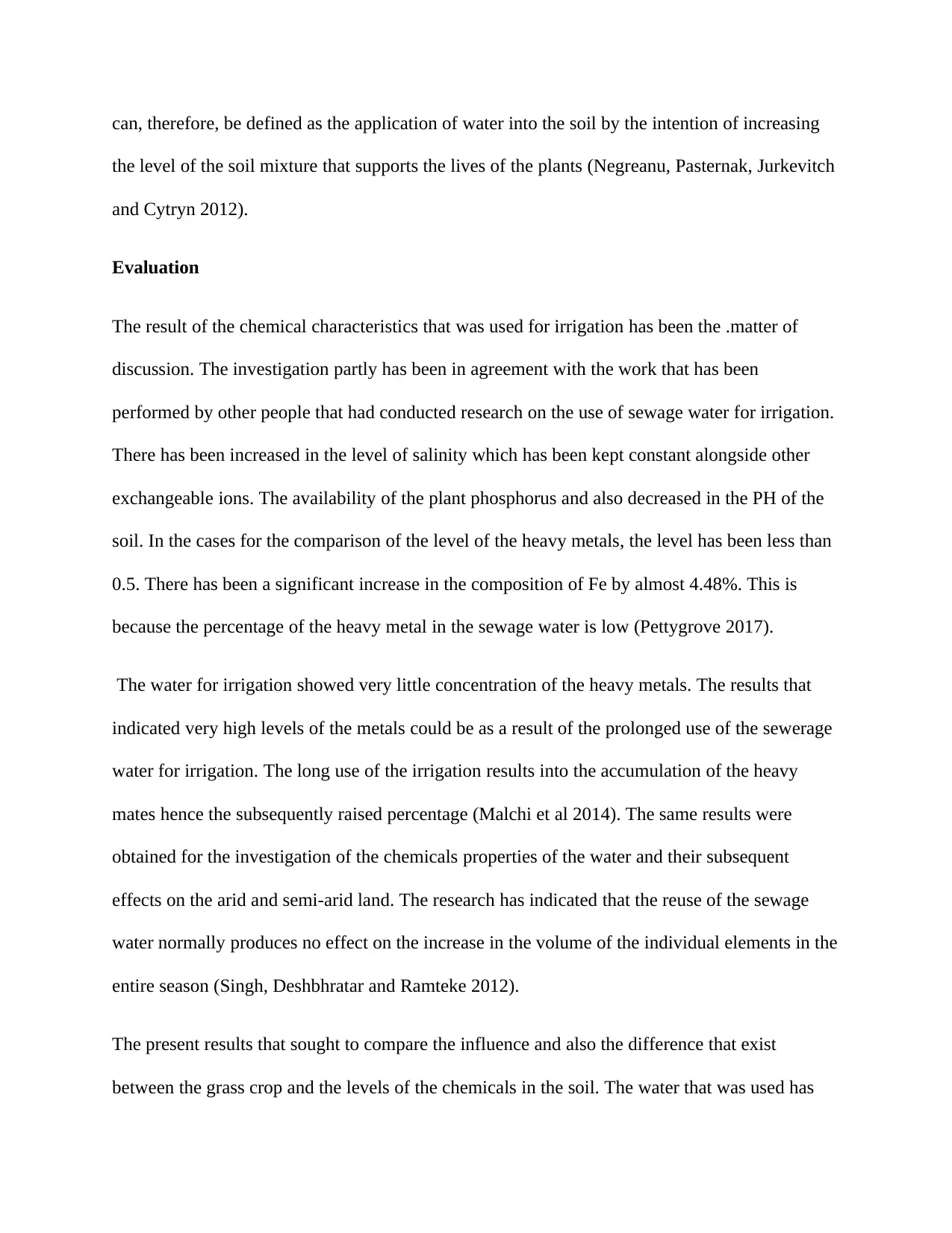
can, therefore, be defined as the application of water into the soil by the intention of increasing
the level of the soil mixture that supports the lives of the plants (Negreanu, Pasternak, Jurkevitch
and Cytryn 2012).
Evaluation
The result of the chemical characteristics that was used for irrigation has been the .matter of
discussion. The investigation partly has been in agreement with the work that has been
performed by other people that had conducted research on the use of sewage water for irrigation.
There has been increased in the level of salinity which has been kept constant alongside other
exchangeable ions. The availability of the plant phosphorus and also decreased in the PH of the
soil. In the cases for the comparison of the level of the heavy metals, the level has been less than
0.5. There has been a significant increase in the composition of Fe by almost 4.48%. This is
because the percentage of the heavy metal in the sewage water is low (Pettygrove 2017).
The water for irrigation showed very little concentration of the heavy metals. The results that
indicated very high levels of the metals could be as a result of the prolonged use of the sewerage
water for irrigation. The long use of the irrigation results into the accumulation of the heavy
mates hence the subsequently raised percentage (Malchi et al 2014). The same results were
obtained for the investigation of the chemicals properties of the water and their subsequent
effects on the arid and semi-arid land. The research has indicated that the reuse of the sewage
water normally produces no effect on the increase in the volume of the individual elements in the
entire season (Singh, Deshbhratar and Ramteke 2012).
The present results that sought to compare the influence and also the difference that exist
between the grass crop and the levels of the chemicals in the soil. The water that was used has
the level of the soil mixture that supports the lives of the plants (Negreanu, Pasternak, Jurkevitch
and Cytryn 2012).
Evaluation
The result of the chemical characteristics that was used for irrigation has been the .matter of
discussion. The investigation partly has been in agreement with the work that has been
performed by other people that had conducted research on the use of sewage water for irrigation.
There has been increased in the level of salinity which has been kept constant alongside other
exchangeable ions. The availability of the plant phosphorus and also decreased in the PH of the
soil. In the cases for the comparison of the level of the heavy metals, the level has been less than
0.5. There has been a significant increase in the composition of Fe by almost 4.48%. This is
because the percentage of the heavy metal in the sewage water is low (Pettygrove 2017).
The water for irrigation showed very little concentration of the heavy metals. The results that
indicated very high levels of the metals could be as a result of the prolonged use of the sewerage
water for irrigation. The long use of the irrigation results into the accumulation of the heavy
mates hence the subsequently raised percentage (Malchi et al 2014). The same results were
obtained for the investigation of the chemicals properties of the water and their subsequent
effects on the arid and semi-arid land. The research has indicated that the reuse of the sewage
water normally produces no effect on the increase in the volume of the individual elements in the
entire season (Singh, Deshbhratar and Ramteke 2012).
The present results that sought to compare the influence and also the difference that exist
between the grass crop and the levels of the chemicals in the soil. The water that was used has
⊘ This is a preview!⊘
Do you want full access?
Subscribe today to unlock all pages.

Trusted by 1+ million students worldwide
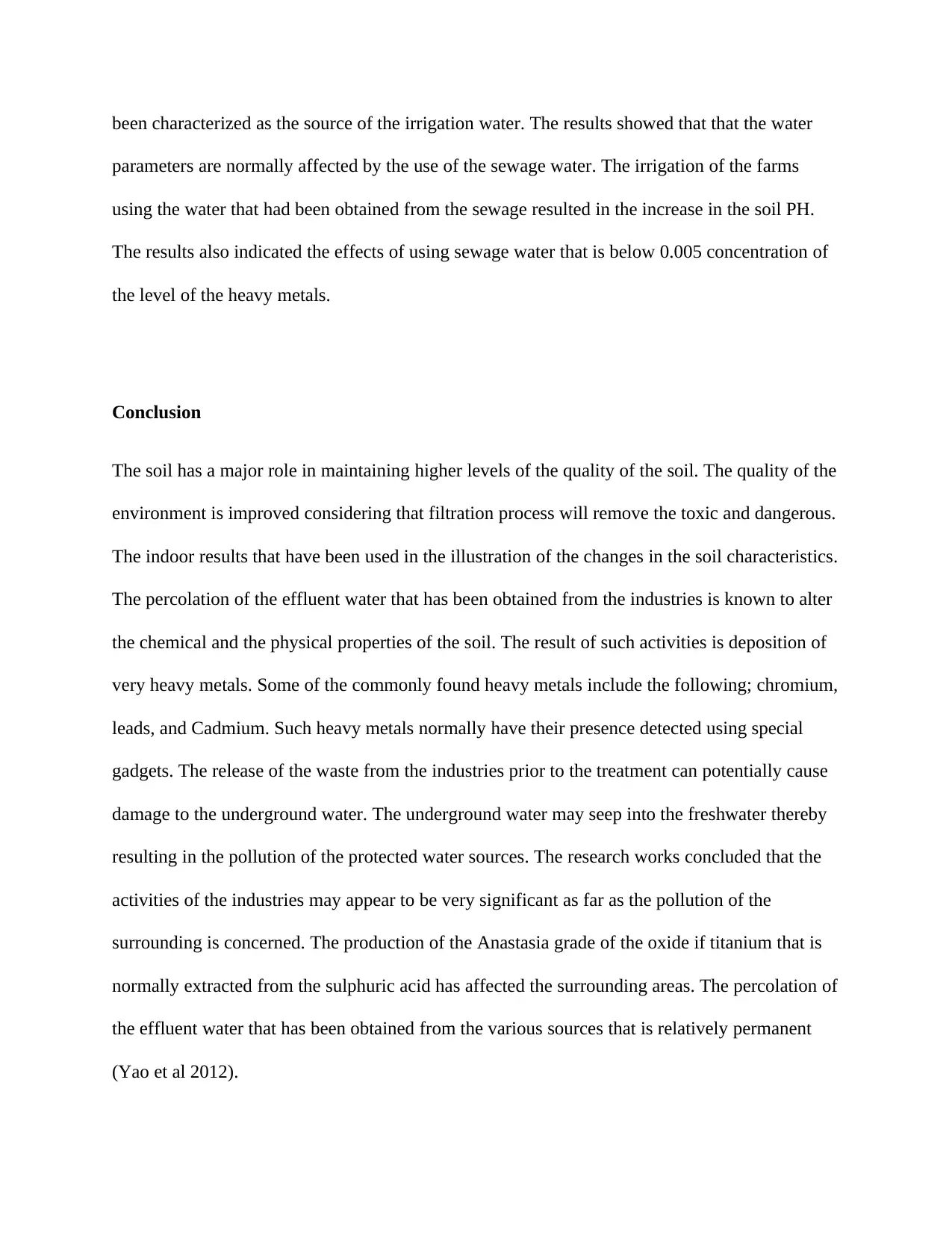
been characterized as the source of the irrigation water. The results showed that that the water
parameters are normally affected by the use of the sewage water. The irrigation of the farms
using the water that had been obtained from the sewage resulted in the increase in the soil PH.
The results also indicated the effects of using sewage water that is below 0.005 concentration of
the level of the heavy metals.
Conclusion
The soil has a major role in maintaining higher levels of the quality of the soil. The quality of the
environment is improved considering that filtration process will remove the toxic and dangerous.
The indoor results that have been used in the illustration of the changes in the soil characteristics.
The percolation of the effluent water that has been obtained from the industries is known to alter
the chemical and the physical properties of the soil. The result of such activities is deposition of
very heavy metals. Some of the commonly found heavy metals include the following; chromium,
leads, and Cadmium. Such heavy metals normally have their presence detected using special
gadgets. The release of the waste from the industries prior to the treatment can potentially cause
damage to the underground water. The underground water may seep into the freshwater thereby
resulting in the pollution of the protected water sources. The research works concluded that the
activities of the industries may appear to be very significant as far as the pollution of the
surrounding is concerned. The production of the Anastasia grade of the oxide if titanium that is
normally extracted from the sulphuric acid has affected the surrounding areas. The percolation of
the effluent water that has been obtained from the various sources that is relatively permanent
(Yao et al 2012).
parameters are normally affected by the use of the sewage water. The irrigation of the farms
using the water that had been obtained from the sewage resulted in the increase in the soil PH.
The results also indicated the effects of using sewage water that is below 0.005 concentration of
the level of the heavy metals.
Conclusion
The soil has a major role in maintaining higher levels of the quality of the soil. The quality of the
environment is improved considering that filtration process will remove the toxic and dangerous.
The indoor results that have been used in the illustration of the changes in the soil characteristics.
The percolation of the effluent water that has been obtained from the industries is known to alter
the chemical and the physical properties of the soil. The result of such activities is deposition of
very heavy metals. Some of the commonly found heavy metals include the following; chromium,
leads, and Cadmium. Such heavy metals normally have their presence detected using special
gadgets. The release of the waste from the industries prior to the treatment can potentially cause
damage to the underground water. The underground water may seep into the freshwater thereby
resulting in the pollution of the protected water sources. The research works concluded that the
activities of the industries may appear to be very significant as far as the pollution of the
surrounding is concerned. The production of the Anastasia grade of the oxide if titanium that is
normally extracted from the sulphuric acid has affected the surrounding areas. The percolation of
the effluent water that has been obtained from the various sources that is relatively permanent
(Yao et al 2012).
Paraphrase This Document
Need a fresh take? Get an instant paraphrase of this document with our AI Paraphraser
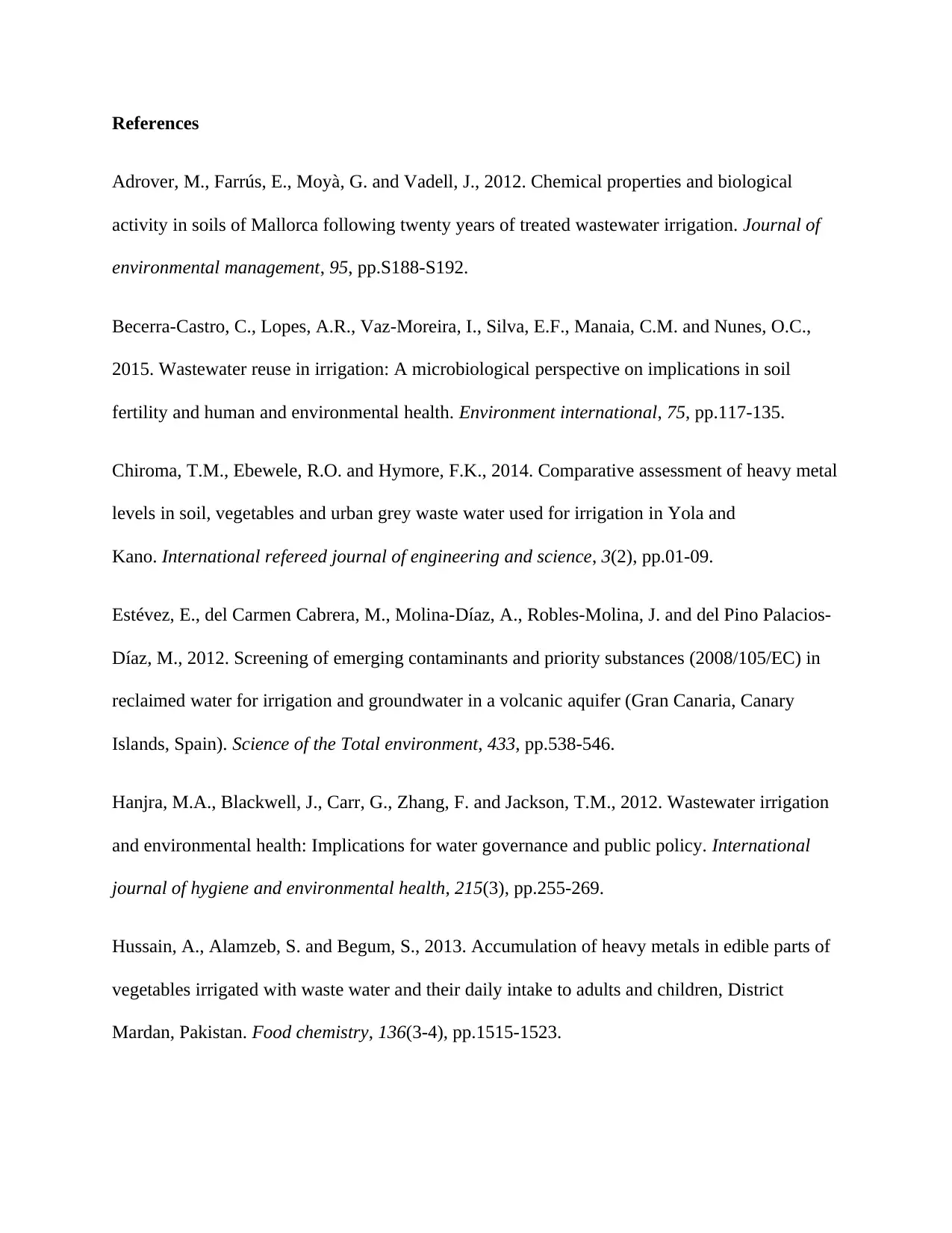
References
Adrover, M., Farrús, E., Moyà, G. and Vadell, J., 2012. Chemical properties and biological
activity in soils of Mallorca following twenty years of treated wastewater irrigation. Journal of
environmental management, 95, pp.S188-S192.
Becerra-Castro, C., Lopes, A.R., Vaz-Moreira, I., Silva, E.F., Manaia, C.M. and Nunes, O.C.,
2015. Wastewater reuse in irrigation: A microbiological perspective on implications in soil
fertility and human and environmental health. Environment international, 75, pp.117-135.
Chiroma, T.M., Ebewele, R.O. and Hymore, F.K., 2014. Comparative assessment of heavy metal
levels in soil, vegetables and urban grey waste water used for irrigation in Yola and
Kano. International refereed journal of engineering and science, 3(2), pp.01-09.
Estévez, E., del Carmen Cabrera, M., Molina-Díaz, A., Robles-Molina, J. and del Pino Palacios-
Díaz, M., 2012. Screening of emerging contaminants and priority substances (2008/105/EC) in
reclaimed water for irrigation and groundwater in a volcanic aquifer (Gran Canaria, Canary
Islands, Spain). Science of the Total environment, 433, pp.538-546.
Hanjra, M.A., Blackwell, J., Carr, G., Zhang, F. and Jackson, T.M., 2012. Wastewater irrigation
and environmental health: Implications for water governance and public policy. International
journal of hygiene and environmental health, 215(3), pp.255-269.
Hussain, A., Alamzeb, S. and Begum, S., 2013. Accumulation of heavy metals in edible parts of
vegetables irrigated with waste water and their daily intake to adults and children, District
Mardan, Pakistan. Food chemistry, 136(3-4), pp.1515-1523.
Adrover, M., Farrús, E., Moyà, G. and Vadell, J., 2012. Chemical properties and biological
activity in soils of Mallorca following twenty years of treated wastewater irrigation. Journal of
environmental management, 95, pp.S188-S192.
Becerra-Castro, C., Lopes, A.R., Vaz-Moreira, I., Silva, E.F., Manaia, C.M. and Nunes, O.C.,
2015. Wastewater reuse in irrigation: A microbiological perspective on implications in soil
fertility and human and environmental health. Environment international, 75, pp.117-135.
Chiroma, T.M., Ebewele, R.O. and Hymore, F.K., 2014. Comparative assessment of heavy metal
levels in soil, vegetables and urban grey waste water used for irrigation in Yola and
Kano. International refereed journal of engineering and science, 3(2), pp.01-09.
Estévez, E., del Carmen Cabrera, M., Molina-Díaz, A., Robles-Molina, J. and del Pino Palacios-
Díaz, M., 2012. Screening of emerging contaminants and priority substances (2008/105/EC) in
reclaimed water for irrigation and groundwater in a volcanic aquifer (Gran Canaria, Canary
Islands, Spain). Science of the Total environment, 433, pp.538-546.
Hanjra, M.A., Blackwell, J., Carr, G., Zhang, F. and Jackson, T.M., 2012. Wastewater irrigation
and environmental health: Implications for water governance and public policy. International
journal of hygiene and environmental health, 215(3), pp.255-269.
Hussain, A., Alamzeb, S. and Begum, S., 2013. Accumulation of heavy metals in edible parts of
vegetables irrigated with waste water and their daily intake to adults and children, District
Mardan, Pakistan. Food chemistry, 136(3-4), pp.1515-1523.
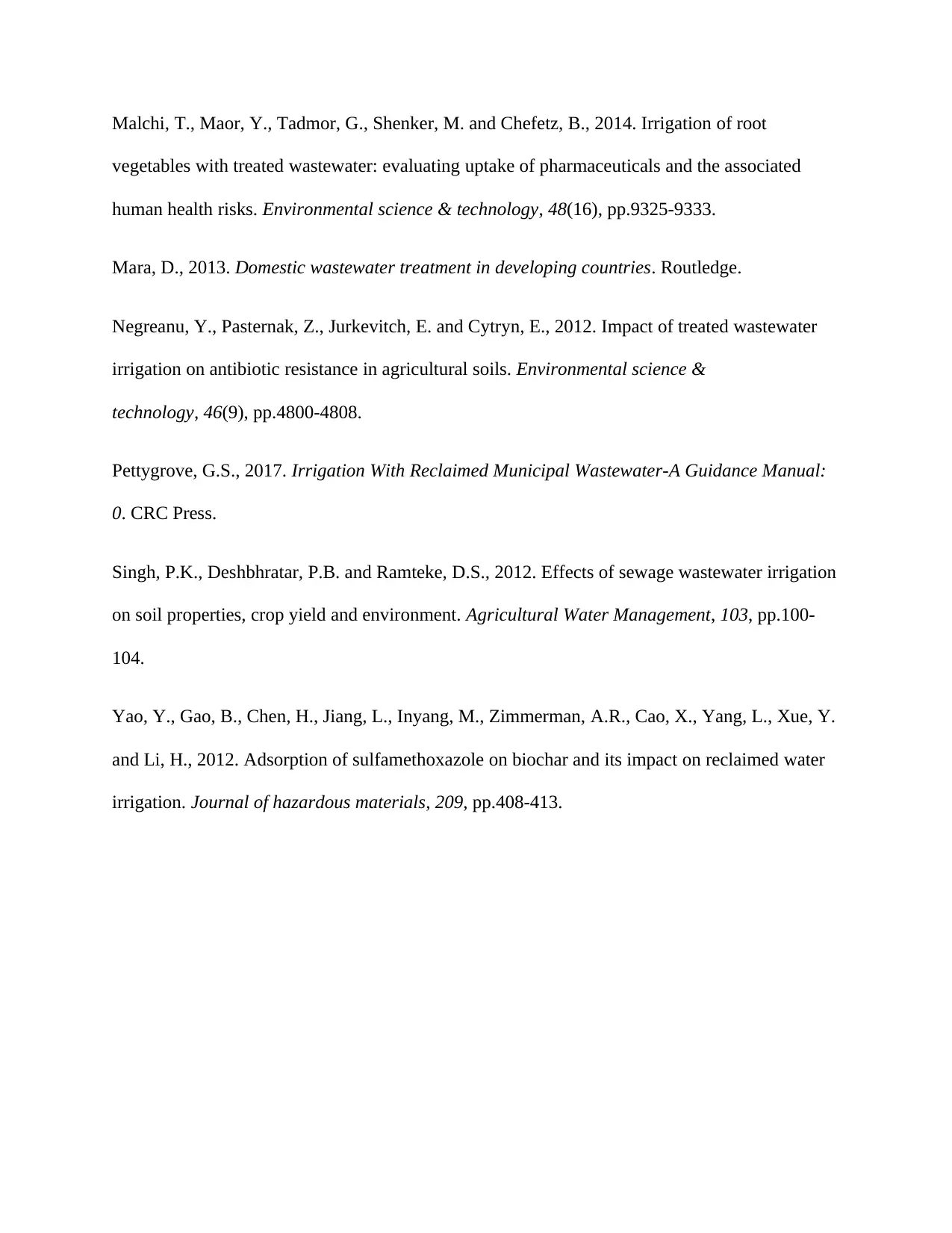
Malchi, T., Maor, Y., Tadmor, G., Shenker, M. and Chefetz, B., 2014. Irrigation of root
vegetables with treated wastewater: evaluating uptake of pharmaceuticals and the associated
human health risks. Environmental science & technology, 48(16), pp.9325-9333.
Mara, D., 2013. Domestic wastewater treatment in developing countries. Routledge.
Negreanu, Y., Pasternak, Z., Jurkevitch, E. and Cytryn, E., 2012. Impact of treated wastewater
irrigation on antibiotic resistance in agricultural soils. Environmental science &
technology, 46(9), pp.4800-4808.
Pettygrove, G.S., 2017. Irrigation With Reclaimed Municipal Wastewater-A Guidance Manual:
0. CRC Press.
Singh, P.K., Deshbhratar, P.B. and Ramteke, D.S., 2012. Effects of sewage wastewater irrigation
on soil properties, crop yield and environment. Agricultural Water Management, 103, pp.100-
104.
Yao, Y., Gao, B., Chen, H., Jiang, L., Inyang, M., Zimmerman, A.R., Cao, X., Yang, L., Xue, Y.
and Li, H., 2012. Adsorption of sulfamethoxazole on biochar and its impact on reclaimed water
irrigation. Journal of hazardous materials, 209, pp.408-413.
vegetables with treated wastewater: evaluating uptake of pharmaceuticals and the associated
human health risks. Environmental science & technology, 48(16), pp.9325-9333.
Mara, D., 2013. Domestic wastewater treatment in developing countries. Routledge.
Negreanu, Y., Pasternak, Z., Jurkevitch, E. and Cytryn, E., 2012. Impact of treated wastewater
irrigation on antibiotic resistance in agricultural soils. Environmental science &
technology, 46(9), pp.4800-4808.
Pettygrove, G.S., 2017. Irrigation With Reclaimed Municipal Wastewater-A Guidance Manual:
0. CRC Press.
Singh, P.K., Deshbhratar, P.B. and Ramteke, D.S., 2012. Effects of sewage wastewater irrigation
on soil properties, crop yield and environment. Agricultural Water Management, 103, pp.100-
104.
Yao, Y., Gao, B., Chen, H., Jiang, L., Inyang, M., Zimmerman, A.R., Cao, X., Yang, L., Xue, Y.
and Li, H., 2012. Adsorption of sulfamethoxazole on biochar and its impact on reclaimed water
irrigation. Journal of hazardous materials, 209, pp.408-413.
⊘ This is a preview!⊘
Do you want full access?
Subscribe today to unlock all pages.

Trusted by 1+ million students worldwide
1 out of 9
Related Documents
Your All-in-One AI-Powered Toolkit for Academic Success.
+13062052269
info@desklib.com
Available 24*7 on WhatsApp / Email
![[object Object]](/_next/static/media/star-bottom.7253800d.svg)
Unlock your academic potential
Copyright © 2020–2025 A2Z Services. All Rights Reserved. Developed and managed by ZUCOL.





